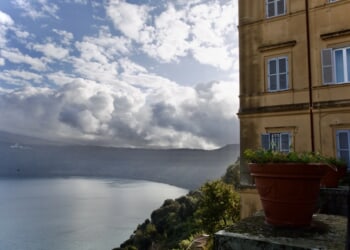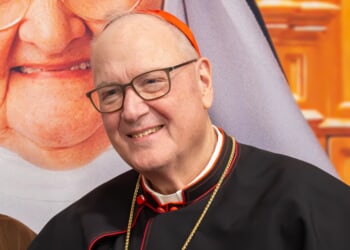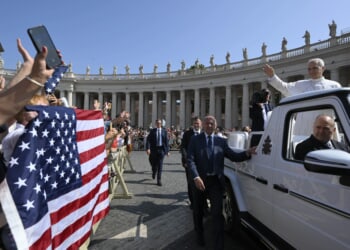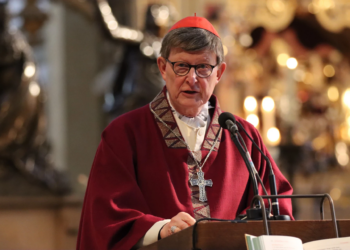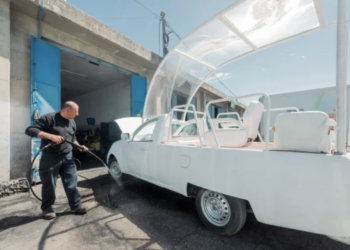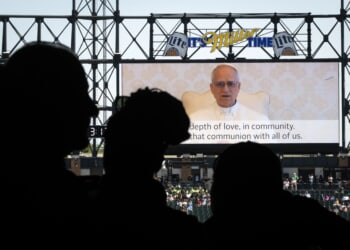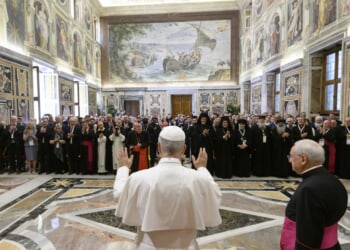Vatican City, May 6, 2025 /
11:12 am
The Sistine Chapel has witnessed every papal election since 1492 with only five exceptions, and it is preparing to once again host the conclave.
The 133 cardinal electors, meeting behind closed doors, will have the task of electing Pope Francis’ successor starting Wednesday, surrounded by the beauty of frescoes by Michelangelo, Pietro Perugino, Sandro Botticelli, and Domenico Ghirlandaio.
Located in the heart of the Vatican and protected by the Leonine Wall, the Sistine Chapel was built on the site of the ancient Cappella Magna. From its origins, it served not only as a place of liturgy but also as a protected space for the crucial decisions that have marked the millennia-long life of the Church.
Its symbolic proximity to the site of St. Peter’s martyrdom also reinforces the spiritual dimension of the election that will take place there.
On Monday, April 28, the Sistine Chapel, named after Pope Sixtus IV, who commissioned its construction between 1475 and 1483, was freed from its usual tourist traffic to adapt to the strict regulations of the conclave and ensure the necessary conditions of hermetic isolation surrounding the cardinals’ votes.
The six-century tradition of holding papal elections here was ratified by St. John Paul II, who emphasized that the space contributes to the experience of divine presence.
From Genesis to Revelation, Michelangelo’s masterful hand will guide the cardinals present through the holy Scriptures from the beginning of the world to the final pages of history in a vibrant catechesis through art that will remind them of the threat of sin and death but also of the hope of eternal life.
As the cardinals gaze up at the ceiling, they will feel the power of the “Creation of Adam,” one of the most famous frescoes by the Italian Renaissance master, hovering over their heads.
Another witness to the historic election will be “The Last Judgment,” which will preside over the conclave from the altar wall. There will be placed the ballot box and the lectern with the Gospel, upon which the cardinals will take their solemn oath.
In this masterpiece, Christ is the universal judge of the living and the dead. Surrounding him are angels awakening the dead with trumpets, skeletons taking on new flesh as the resurrection of the dead progresses, and numerous saints and martyrs populating heaven.
Below, Charon, with his boat, facilitates the passage from death to hell, showing the damned their destiny. And, at the very top of the fresco, the symbols of Christ’s passion are clearly visible: the column where he was scourged, the dice with which his garments were divided, the crown of thorns, and above all, the cross, which emphasizes the path to heaven.
First-time cardinals are often overwhelmed by the visual grandeur that surrounds them. Painted by the greatest Renaissance artists, the works of the Sistine Chapel speak to consciences, as pointed out by Pope Benedict XVI, who, on the occasion of the 500th anniversary of Michelangelo’s vault in 2012, invited people to interpret the works with the help of prayer in his address.
“Praying in the Sistine Chapel, enveloped in the story of God’s journey with humanity, admirably represented in the frescoes above and around us, is an invitation to praise, an invitation to raise to God, creator, redeemer, and judge of the living and the dead, with all the saints in heaven, the words of the Canticle of Revelation: ‘Amen! Alleluia!’” he asserted.
In fact, the artists Michelangelo, Botticelli, Ghirlandaio, and Perugino did not work alone: The iconographic themes were dictated by the most experienced theologians of Popes Sixtus IV and Julius II, who commissioned their decoration.
This is the only way to explain the coherence between the frescoes of Genesis, the scenes from the lives of Moses and Christ, and the Last Judgment that crowns the apse.
Measuring about 132 feet long, 44 feet wide, and over 65 feet high, the Sistine Chapel exudes a serene atmosphere. At the beginning of the conclave on Wednesday, the cardinals will enter in procession, intoning the “Veni Creator Spiritus.” Each will take their assigned place after solemnly swearing a commitment to secrecy.
(Story continues below)
Subscribe to our daily newsletter
The pope is a martyr
But before all this, the cardinals will pass through the Pauline Chapel, which houses the frescoes depicting the crucifixion of St. Peter, painted by Michelangelo between 1546 and 1550.
Known as the “capilla parva,” meaning “small chapel,” in contrast to its neighboring Sistine Chapel, this precious sacred space, inaccessible to the public, is reserved for the pope and the exposition of the Blessed Sacrament.
The powerful image of St. Peter crucified upside down, a symbol of his martyrdom, is above all a visual reminder that the pope is a martyr: a fundamental message for the cardinals when electing his successor.
Mozart was also moved by its beauty
The Sistine Chapel has not only been the scene of papal elections but also of great liturgical celebrations. According to tradition, in the mid-18th century, the young Wolfgang Amadeus Mozart traveled to Rome and was fascinated by Gregorio Allegri’s “Miserere.” This composition could only be performed here during Holy Week, as the score was closely guarded by the Vatican.
Today, the Mass of the Epiphany is regularly celebrated in the Sistine Chapel, where both Pope Francis and Benedict XVI have baptized some of the children of Vatican employees.
Over the centuries, this space, overflowing with beauty, has been restored several times. For example, between 1980 and 1999, an exhaustive cleaning was carried out to remove the dirt caused by the dust, soot, and wax accumulated over the centuries.
The Sistine Chapel continues to dazzle the millions of people who visit it each year — an aesthetic ecstasy that will also be experienced by the cardinals who, for many the first time, will sit beneath its dome to discern the future of the Church.
This story was first published by ACI Prensa, CNA’s Spanish-language news partner. It has been translated and adapted by CNA.






